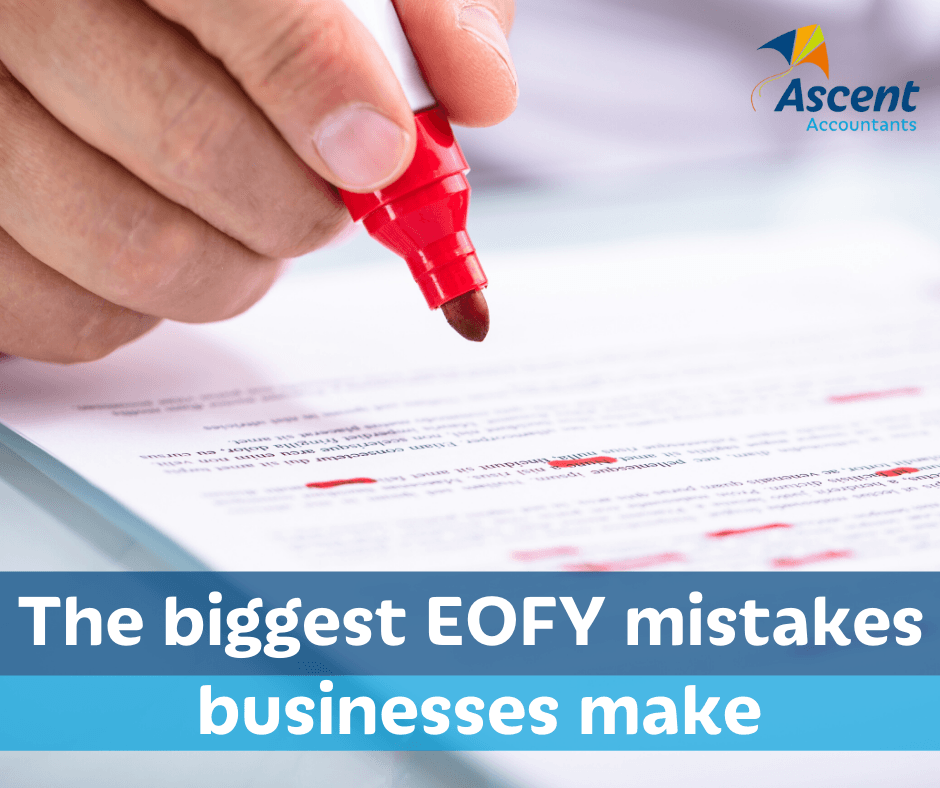The biggest EOFY mistakes businesses make

Mistake one: Not staying in regular contact with your accountant
Unless you’re experienced in accounting yourself, hiring a professional accountant or bookkeeper is a must for your business.
It makes it so much easier to keep up to date on any accounting or tax changes, to get regular advice on how to grow your business and to help you maximise your position at tax time.
This being said, it’s unfortunately very common for businesses to only reach out to their accountants and bookkeepers at the end of the financial year. By this point, accounts are often a complete mess and its near impossible to have a solid gauge of the financial position of your business.
Engaging with your accountant or bookkeeper regularly throughout the year helps to avoid so many issues and makes the end of the financial year a much less stressful and overwhelming experience. You are able to receive advice for your business throughout the whole year and will have the confidence that your business accounts are up to date, ensuing smooth sailing all year round.
Mistake two: Not ensuring that your accounts are up to date
Not keeping your business accounts up to date may seem like an obvious mistake, but it’s also a very common one businesses make.
Having to check a backlog of old business accounts can be very tedious, time consuming and stressful. It can also affect the consistency and clarity of the information provided in support of your business financial statements. Not only this, but not keeping track of incoming and outgoing cashflow in your business can land your business in some difficult positions.
This can be avoided by utilising accounting software that is specifically designed to help businesses keep records and accounts.
Mistake three: Leaving financial statements to the last minute
Leaving business financial statements to the last minute is another obvious mistake that is all too common.
To ensure better quality and accuracy, these sort of things need to be done as they come in, rather than rushed and in bulk at the last minute.
Like the last two mistakes, this can easily be avoided by hiring someone to help keep on top of everything and/or to utilise software that is specifically made for this purpose.
Mistake four: Not being clued up on business accounting software and functionality
So many mistakes can be avoided simply by using the right accounting software for your business and using it well.
When used correctly, it can be hugely beneficial to make sure that business accounts are up to date, which makes the end of the financial year a much easier time for everyone within your business.
Using this kind of accounting software can help you track cashflow, key expenditure, inventory, payroll, billing and invoice management and ATO payments such as GST.
It is well worth either really getting yourself familiar with these systems, or hiring someone else within your business who is.
Mistake five: Not keeping adequate records and supporting information for financial statements
Being unprepared causes so many issues when it comes to business finances.
Business accounts and records need to be reconciled, updated and contain enough detail and supporting documentation.
The end of the financial year can be a challenging time for a business if this is not done. Especially if you want to maximise potential deductions. Having a sound and up to date knowledge of the business expenses you can claim as a business is all well and good, but you need solid business records in order to lodge your claims with the ATO.
With so many easy mistakes that can be made by businesses, the biggest and most important thing to remember is to keep your accounts, financial statements and records up to date which is best done either with business accounting software or by enlisting the help of a professional accountant or bookkeeper.
Need help with your accounting?








